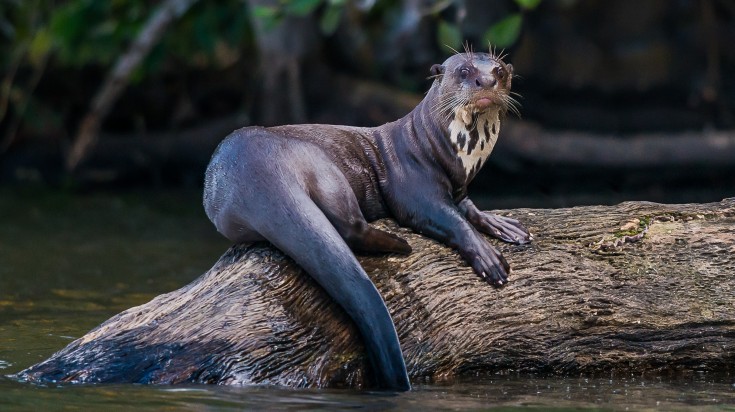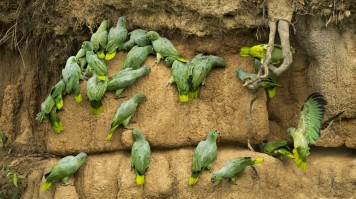12 Things To Do in Manu National Park

- Angelo V
- From
- Angelo V
- From
- Zalina A
- From
- Yfat Y
- From
Manu National Park Highlights
- See some of South America’s most iconic species in close quarters
- Visit local indigenous communities and learn traditional ways of life
- Night walk into the jungle to catch sight of elusive nocturnal creatures
- Take river trips surrounded by jungle teeming with animals and birds
- Gain understanding of life in the treetops from canopy walks
Manu National Park lowlights
- Trips into the reserved zone operated by only a handful of companies and can be expensive
- The park is remote and difficult to reach
What to do in Manu National Park?
Below we present you with 12 things to do in Manu National Park, listed in no particular order:
1. Take a night walk
Not for the faint of heart, an eerie walk into the jungle after nightfall offers the chance to catch sight of nocturnal animals that are not active during the day. A cast of creatures including insects and amphibians emerge after dark and a night walk is the only way to see them.
2. Visit Lake Salvador
Deep in the reserved zone and far from civilization, Lake Salvador is home to a large number of animal and bird species and a tour of the lake is an excellent opportunity to try to spot some of the more elusive residents of the park. Animals to look out for include monkeys, caiman, capybara and river turtles.

3. Visit Lake Otorongo
Lake Otorongo is another unmissable spot and home to a range of wildlife. The lake features a specially-constructed tower for spotting birds and animals.
4. See giant otters
One of the most impressive species to be found in the area is the giant otter, which can grow to 1.8m in length. They live in family groups and are present in many of the lakes in the area. Visitors have the chance to watch them hunting, eating and playing together in their natural habitat.

5. See the cock-of-the-rock bird
The cock-of-the-rock is Peru’s national bird and is known for its bright red colour and its ostentatious courtship dance. A trip to the Manu cloud forest is an excellent chance to catch sight of these birds and to witness the elaborate dance they perform in an attempt to attract a mate.
6. See macaws at clay licks
One of the highlights of any visit to Manu National Park is a trip to one of the macaw salt licks where hundreds of the brightly colored birds congregate to obtain salt and minerals necessary to supplement their diet. An unmissable experience for anyone with even a passing interest in ornithology.


7. Visit the petroglyphs of Pusharo
Travel to Palotoa-Teparo, a Matsiguenka indigenous community and stay in the Pusharo Lodge. There are good nature walks here but the main attraction is the petroglyphs of Pusharo, mysterious ancient rock carvings located near the settlement. The local community organizes visits but a permit must be obtained in Cusco in advance.
8. Do a canopy walk
To see the jungle from a different perspective, take to the treetops in a canopy walk. In rainforests, much of the action takes place far above the ground, and a canopy walk gives visitors a deeper understanding of life in the trees.
9. Camp in the jungle
To fully experience the jungle, try camping out, surrounded only by darkness and the sounds of the night.

10. Visit local communities
Several of the settlements in the cultural zone have facilities for receiving tourists. Meet indigenous peoples and learn about traditional ways of life of the local Yine and Matsiguenka communities.
11. Take a river tour
An excellent way to fully appreciate the park is to simply take a tour on the river. Knowledgeable guides can help point out wildlife that would otherwise be very hard to spot.

12. Go whitewater rafting
There are plenty of opportunities for adventure in Manu and the grade I and II rapids near Pilcopata offer a chance at a small adrenaline rush against the scenic backdrop of lush jungle.
How to get to Manu National Park
By land
Buses run from Cusco to Pilcopata, Atalaya, Salvacíon, Shintuya and Itahuania, settlements within the cultural zone. There is no road after Itahuania and further travel into the reserved zone is by boat. Salvacíon is the largest town and makes a good place to stop for the night to break up the journey. The drive to Salvacíon takes 10–12 hours. From Itahuania, it is a further 55km to the village of Boca Manu and the entrance to the reserved zone.
By air
There is now an airstrip at Boca Manu and it is possible to fly directly from Cusco. The flight takes around 40 minutes. From Boca Manu, onward travel is by boat.
The best time to visit Manu National Park is during the dry season, which runs from May to August. Although it can be a challenge to reach, its remoteness makes Manu National Park in Peru one of the prime locations in the world for close and intimate encounters with some of the wonders of the natural world.
Aside from visiting Manu National Park, there are plenty of exciting things to do in Peru. If you are interested in trekking in Peru then make sure to check the 10 best treks in Peru.







